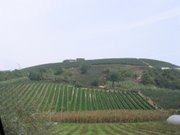When Sunita launched garlic as her 'Think Spice' theme, I felt immediately excited and involved: garlic is definitely the Italian spice, the only one that we really use a lot (together with a few other ones). So, for once, I felt perfectly at ease with a spice theme! But then I started wondering: garlic is so widespread in Italian cuisine, which dish doesn't contain it? There are some dishes that definitely would not exist without garlic, which everybody knows and loves: pesto, tomato sauce (here called 'marinara'), bruschetta. But for this event, I wanted to present something that was an 'ode' to garlic, and if possible, not too well known outside Italy. That's how I thought about 'bagna caoda'. Literally, the name of this dish means 'hot bath': and it is, in fact, a hot, extremely garlicky bath, for vegetables! It's a dish traditional from Piemonte, my region, and it's eaten in winter time. So, what could be more perfect for the 'Think Spice' event? I prepared it yesterday, and we threw a large party in its honor. It was a lot of fun! And to my surprise, everybody loved bagna caoda: I had prepared some back-up pizzas, just in case, but they didn't seem to be necessary..
So here is the recipe for bagna caoda. As you will see, it requires a huge amount of garlic and olive oil, and anchovies. I prepared also a vegetarian version, without anchovies, with chili peppers instead, which was also quite good, and appreciated by vegetarians and people who didn't like anchovies. The whole bagna caoda experience involves a few particular vegetables to dip in, together with some more common ones. Luckily enough, Berkeley Bowl provided also the 'particular' ones!
Bagna caoda
Ingredients for about 15 people, or a few cans:
8 heads of garlic (not cloves, heads!!)
1 lb anchovies under salt (I found them imported from Italy, in a huge 1 kg can, again at the Berkeley Bowl - they should be whole, preserved only under salt and nothing else)
~3/4 liter olive oil
Vegetables: potatoes, onions, peppers, celery, beets, fennels, Jerusalem artichokes, cardoons, cabbage, turnips are traditional. We also added mushrooms, parsnips, carrots, zucchini, celery roots, broccoli, brocco-flowers.
To make the sauce, peel all the garlic, and cut it into thin slices. Clean the anchovies by removing the central bone and interior parts, and then wash them from the salt. Put all the garlic pieces and anchovies in a pot, and cover with oil. You should use about 3/4 liter. Cook on very low heat for about two hours, until the garlic is very soft, and then squish all the pieces with a spoon, till a sort of olive oil/garlic/anchovie paste is obtained. You should add a generous piece of butter to this sauce before serving it, but I forgot to do it, and I must say, it was delicious also in my 'healthier' version.
For the vegetarian version, cut the garlic into slices, and cover with oil and cook in a similar way. Add pieces of chili peppers and salt to taste while cooking. The problem of this version is that the garlic tends to clump separately from the oil (apparently the anchovies have also a 'surfactant'-like function...). It's good in any case. If you want, you can add some cream (the famous 'panna da cucina' which I already mentioned in this post), to help the formation of a paste. This will make it a little less traditional, but the most 'modern' versions of bagna caoda add this cream in any case, to smooth the taste of the garlic.
In the meanwhile, prepare the vegetables: bake the potatoes, onions, beets, turnips, parsnips and peppers. Slice all the vegetables that need to be (the baked ones and the raw ones), or simply cut into 'handy' pieces the veggies such as carrots or celery or cardoons. The goal is to have pieces that one can dip in the sauce and eat conveniently.
The best way to serve bagna caoda is having it on the table on top of the traditional burners, such as those used for fondue, with a candle in it: the bagna needs to remain caoda (=calda, i.e. hot, in Piemontese dialect), while you eat it. Our arrangement was a little less elegant, but still worked..: The bagna caoda was set on an oven rack, with a candle below it.. :)
The bagna caoda was set on an oven rack, with a candle below it.. :)
At this point, you're set: start dipping the veggies in the sauce, and eat them! The most fun part is to try the taste of the sauce with all the different vegetables. Here is only a small portion of the vegetables we had: Everybody brought some veggies, according to what I suggested, and we ended up with a real feast for the eyes and the stomach. I baked also some bread, which is also delicious to dip in the sauce, of course.
Everybody brought some veggies, according to what I suggested, and we ended up with a real feast for the eyes and the stomach. I baked also some bread, which is also delicious to dip in the sauce, of course.
I'm sure someone is curious about those weird vegetables that I named above. So here they are:
Jerusalem Artichokes These are apparently also known as 'sunchokes' in English. Their Italian/Piemontese name is 'tobinambur', 'topinabo', and variations on this theme. They look like potatoes, but they are much crispier. You can eat them raw, baked, or in casseroles. We baked them for the bagna caoda, and they acquire a very delicate and nutty taste, this way.
These are apparently also known as 'sunchokes' in English. Their Italian/Piemontese name is 'tobinambur', 'topinabo', and variations on this theme. They look like potatoes, but they are much crispier. You can eat them raw, baked, or in casseroles. We baked them for the bagna caoda, and they acquire a very delicate and nutty taste, this way.
Cardoons(picture from 'The seasonal chef', as I forgot to take mine).
These are called 'cardi' in Italy, and there is actually a special variety that one should use for bagna caoda, called 'cardo gobbo', which is 'hunchback' (='gobbo') compared to the straight one that you see in this picture. It's a really strange vegetable. Bitter and tough, better to eat it raw to avoid the bitterness become intolerable. Forget about eating the leaves, too, they are super bitter. In any case, they go nicely with the strong contrasting taste of bagna caoda.
Well, so here is my (late) entry to Sunita's event, and I hope everybody enjoyed reading about this traditional dish from the 'cuisine for the poor' of Piemonte! Check the roundup here!
Sunday, January 27, 2008
Bagna caoda
Posted by
chemcookit
at
1:42 PM
![]()
Labels: recipes (sauces), recipes (vegetables), think spice
Subscribe to:
Post Comments (Atom)







2 comments:
I loved reading about your dish..very unique...thanks for sending it over...the wait was worth it :-0
What a great post, Marta. I have not had gobbi in ages. I can only imagine how charmed your guests were. I love anchovies and I am glad you found the simply salted ones. Do you ever eat them on buttered toasted bread?
Post a Comment